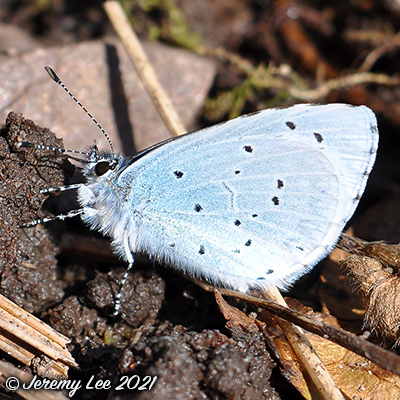
 |
|
Scientific Classifications explained » Amphibians » Ants » Aphids » Bees » Beetles » Birds » Bugs » Butterflies » Caterpillars » Damselflies » Dragonflies » Earwigs » Flies » Frog/Leafhoppers » Fungi » Galls » Grasshoppers » Harvestmen » Hoverflies » Lacewings » Ladybirds » Leaf Mines » Lichens » Mammals » Millipedes » Mosses » Moths » Sawflies » Slugs » Snails » Spiders » Trees & Shrubs » Wasps » Wild Flowers » Woodlice » Postboxes |
UK Nature > Butterflies > Celastrina argiolus

Scientific Name: Celastrina argiolus Common Name: Holly BLue Celastrina argiolus, more commonly known as the Holly BLue, is a small butterfly (wingspan 30mm), light silver blue in colour with black borders to the upper wing which are more defined in females. It can be distinguished from other blue butterflies by the black speckles on the underside of its wings. Depending on temperatures and location, the holly blue can have between one and three broods in a year. Females lay small, flat white eggs on foodplants. The hatched caterpillar goes through several moults before it leaves the foodplant to pupate close to the ground, where it turns a light mauve. Those that pupate in spring emerge after a few weeks but the later brood overwinters as pupae. Holly Blues can be seen in woods, parks and gardens in England, Wales and Northern Ireland, but are not frequent in Scotland. Yearly numbers fluctuate but they are increasingly common. |
|

https://www.uknature.co.uk is a website dedicated to showing the immense diversity of UK nature and wildlife. Our vast range of habitats, from lowland arable to snow covered mountains, from storm-ravaged coastlines to peaceful inland freshwater lakes and rivers, from dry, sandy heaths to deciduous and coniferous forests, all these habitats contribute to the abundance of UK nature. We have wild birds in huge numbers either residing or visiting our shores (597 recorded species as at July 2013) and we must also not forget the humble back garden with its grass lawns, flower beds filled with nectar rich flowers, shrubs and trees, all designed to attract huge numbers of insects such as bees, moths, butterflies and hoverflies; and finally the small ponds which provide safe havens for frogs, toads, newts and even slow worms and grass snakes. www.uknature.co.uk is the showcase for my personal passion, photographing uknature in all its glory. I sincerely hope you all enjoy the fruits of my labours. This site and all images contained therein is © Jeremy Lee 2004 - 2025. All Rights Reserved. Site design by Jeremy Lee. Site development & IT Support by Stuart Lee. |